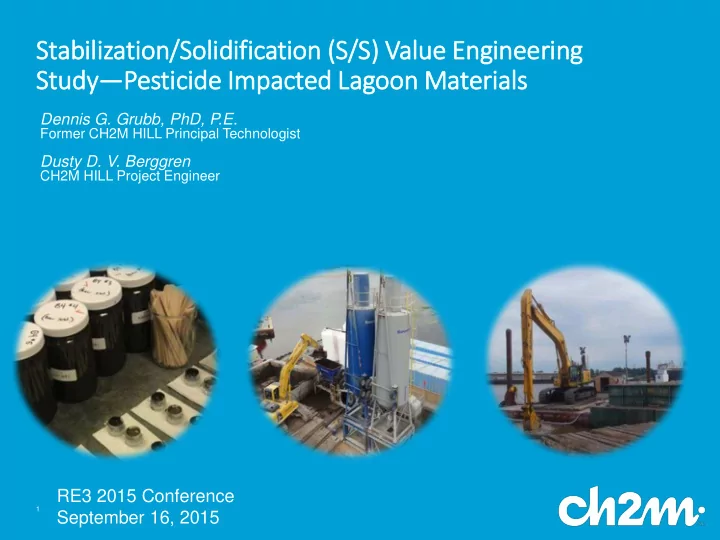

St Stabiliz ilizatio ion/Solid lidif ific icatio ion ( (S/S) S/S) V Valu lue E Engin ineerin ing Study—Pes St esticide I de Impact cted L d Lagoon M n Mater erials Dennis G. Grubb, PhD, P.E. Former CH2M HILL Principal Technologist Dusty D. V. Berggren CH2M HILL Project Engineer RE3 2015 Conference 1 September 16, 2015
Pesticide-Impacted Confidential PRP Site E1315 testing on pesticide-impacted residues Several mg/L BHC compounds (Lindane) Told not to run totals (mg/kg) or we would ruin our analytical equipment Concern: SPLP has tendency to lead to reagent overdosing 2
Pesticide-Impacted Confidential PRP Site Lagoon Area with Pesticide-impacted residues Lagoon over shallow bedrock (24,000 CY) VOCs, SVOCs, pesticides (wt%) as main COCs Upper Fill, Residues/powders, Residual soil Key COCs BHC compounds Chlorinated benzenes Contractor treatability study SPLP results used for mix design selection proposed 2% GAC Reagent cost: $0.75/lb; $50/CY treated CH2MHILL conducted supplemental study SPLP vs. E1315 leaching tests % Reduction basis Cohesive residue materials highly plastic, had to be peeled Reduce or eliminate GAC% off of augers 3
Comparing EPA Methods 1312, 1315 and 1315M Method 1312 (SPLP): ‒ Simulates acid rain exposure ‒ Extraction fluid based on buffer capacity of waste ‒ 100% passing 3/8-inch sieve ‒ L:S ratio 20:1; 18 hours contact time, 1 data point Method 1315 (Semi-Dynamic Leaching) ‒ DI Water leach ‒ L:S ratio 10:1; 2 hour to 14-day contact time; ‒ Total duration between 60 to 90 days; 9 min data points 4
EPA 1315 and EPA1315M EPA Method 1315 (Semi-dynamic Leaching) ‒ Rates of diffusion through solid ‒ Inorganic species only ‒ Monolithic or compacted granular materials ‒ DI water leachant at 9 mL/cm 2 surface area ‒ 9 intervals; 2-hr to 14-day; total of 63 days ‒ Extend leaching intervals as needed Method 1315M (Semi-dynamic Leaching) ‒ Modification to address VOCs & SVOCs ‒ Uses polydimethylsiloxane (PDMS) jar liner ‒ PDMS acts as infinite sink for VOCs/SVOCs ‒ ZHE configuration ‒ Analyze water bath and extract PDMS • MeOH for VOCs • Acetonitrile for SVOCs/pesticides 5
Method 1315M Water Bath Concentrations vs Effective Concentrations (water + PDMS liner) In 1315M PDMS acts as a sink for organics, suppressing water bath concentrations and maintaining strong concentration gradient. Since ANSI 16.1 does not use a PDMS liner, water bath concentrations of VOCs & SVOCs can reach effective water saturation (e.g. SPLP of untreated material), reducing the measured release from the material and invalidating the assumptions of the test. 6
Site Profile and TS Objectives Blending proportions based on LA31 location Upper Fill (UF) (1/6) 4 ft thick Powder Paste (PP) (1/3) 8 ft thick Residual Soil (RS) (1/2) 12 ft thick UF and PP screened for oversize & fibers Contractor treatability study SPLP results used for mix design selection proposed 9% PC/SC plus 2% GAC Reagent cost: $0.75/lb; $50/CY treated CH2 conducted parallel study SPLP vs. E1315 leaching tests % Reduction basis Reduce/eliminate GAC based on more appropriate testing protocol 7
SPLP Results on 28-day cured samples 2% GAC ASL treatment versus WRS field samples SVOC data similar Most pesticide data similar except BHC Most VOC data similar except TCB, DCB Why? Key Differences… ASL very homogenized Field heterogeneity >50% of upper soil & cobbles removed in field LA31 depth approximately 4 to 18 ft bgs in field Powder paste >50% of waste mass in field Powder paste ~33% in ASL surrogate 8
SPLP Results on 28-day cured samples 9
Alkaline Hydrolysis of BHC Compounds Minor detection of chlorobenzenes under natural conditions (biotic transformations at near neutral pH) Alpha, delta, gamma BHC undergo alkaline hydrolysis or “Dehydrochlorination.” At high pH: H, Cl cleaved from hexane ring Benzene ring formed First byproduct is trichlorobenzene (TCB) Chlorinated phenols can also result GAC is catalyst for reaction BHC compounds should leach at lower concentration or slower than “diffusion controlled” conditions. Chorobenzenes (less hazardous) should “appear” in mix design SPLP and E1315 data. Source: Kubatova et al 2002 10 10
Transforming SPLP (mg/L) to mass flux (mg/m 2 ) Upper Table: Use site K, gradient, soil density to get “elapsed time” to attain the L:S=20:1 used by SPLP test, assuming saturated flow conditions Lower Table: Estimate mass flux (mg/m 2 ) for each COC for each elapsed time used to bracket expected site conditions (depends on K, v, gradient, n eff ) 11
Select E1315 data--Gamma BHC Gamma BHC leaching (flux) looks to be largely diffusion controlled. Approaching 90% reduction of untreated site transformed SPLP data. Minor differences (2x to 4x) between 0% to 2% GAC, both well below SPLP data. 12
Select E1315 data—Delta BHC Delta BHC leaching (flux) looks to be significantly diverging from expected diffusion controlled condition. Since high initial concentrations, could be key contributor to TCB generation. 13
Select E1315 data--Trichlorobenzene TCB release greatly exceeds diffusion controlled leaching rates owing to its creation. Exceeds site transformed untreated SPLP data because of low initial concentrations. Very minor differences in GAC content. GAC limited catalyst? Reactions in water bath? 14
Select E1315 data– gamma BHC interval flux Gamma BHC leaching (flux) looks to be largely diffusion controlled. 15
Select E1315 data– TCB interval flux TCB leaching (flux) is constant to slightly increasing, greatly exceeding diffusion controlled conditions. 16
COC % Reduction Comparison Confirmed Contractor SPLP performance E1315 results showed much better removal than E1312 (SPLP) results for same mix designs Recommended elimination of 2% GAC at expected cost of $1.17 to $1.55 million (reagent cost only). Provided mass fluxes to be used in subsequent GW modeling activities for POC evaluations. 17
Thank Y You ou For or You our T r Time Robert Cipolletti, CPG Commercial Technology Manager Direct: 774-284-4633 bob.cipolletti@ch2m.com 18
Recommend
More recommend